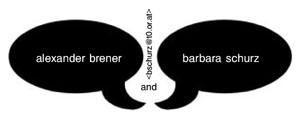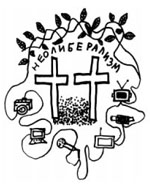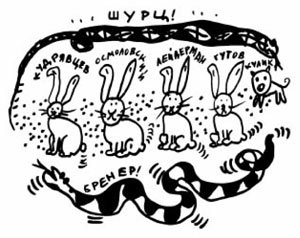| << | CFront - The Newspaper - pp. 10-11 | >> |
|
Current Forms of Power Relationships within the Hegemony of the "West/East" Culture Modelalexander brener and barbara schurz <bschurz@t0.or.at> When we are talking about power relationships we use Foucault's terminology and seek support in the image he worked on for the way that power functions in modern society. As we know, under `power' Foucault primarily sees a diversity of relationships populating and organising a region, as well as strategies within which they achieve their effectiveness. According to Foucault, power is not an institution, not a structure, not one power belonging to a few who are empowered. `Power' is the name given to a complex strategic situation within a society. Power is not something that one attains, removes or shares. Power takes place at innumerable points in the game of unequal and movable relationships. We are now going to attempt to analyse a few of the types of power relationships functioning within the framework of the contemporary art system which are being brought up to date by the current culture-specific game of "West/East". Right at the start we would like to stress that the types of power relationships we analyse here spread and received structural support primarily as a result of the ongoing globalisation of capitalism. Precisely this globalisation provoked and created the current situation in international (and primarily European) art. It is this globalisation that has engendered the now current theme of "West/East". It is this globalisation that rendered such new projects as After the Wall possible at all, as well as the Aspects/Positions. 50 years of Central European Art 1949 - 1999 exhibition in Vienna and other cultural events.
The contemporary international art system represents a functioning culture model of the great neo-liberal political system and is part of it. This model is designed to work out new socio-cultural strategies and ideologies, to separate categories and evolve formulations, and to test these in the artworld ghetto. These ideologies and formulations are delivered by a specific "discourse industry" which does not itself, of course, belong to the fields of philosophy, sociology, political science or aesthetics, but which is linked to these disciplines via art criticism, magazines, the Internet and curators. Who provides artists with their ideas, strategies, concepts and themes in this way? It is not Paul Virilio, not Slavoj Zizek and not Judith Butler, but the system itself that adapts Zizek, Virilio, Butler et al. by means of its various agents, and adapts them to suit its own aims. A little philosophical slapdash, a little aesthetic blur, a little political drivel is what characterises the discrete charm of the "discourse industry" and the art system as a whole. Speed, trend and superficiality, these are the three piers on which the system supports itself. The political turn of events in the last years has created a trendy theme, especially in the European context: "West/East". The possibility that some of the former Eastern-Bloc countries might be joining the European Union gave the East-European culture scene an aura of novelty and up-to-dateness. The trans-national and pseudo-internationalist strategies of the neo-liberally oriented institutions awakened public interest in art from Eastern Europe. The neo-colonial tendencies of today's cultural and economic globalisation have provoked a series of culture-specific scandals (such as the infamous Interpol exhibition in Stockholm) that have finally forced the Western experts to preoccupy themselves with the selection and categorisation of aesthetic phenomena coming from the East. The rules of repressive tolerance demanded of the Eastern European experts (critics, curators and art historians) that they be integrated in the game. In this way, the current situation was formed in which, within a few months, we have become witnesses of (or participants in) a series of art projects that are linked to the model "West/East" in one way or another. These projects are being realised in Stockholm, Vienna, Paris, Ljubljana and Prague, in the entire realm of global capitalism. The falsified and predetermined view of the most recent Eastern European art they construct is a result of the corrupted consensus. The determining characteristic of all these projects is their neo-colonial character. What do we mean by this? Above all, all of these official representations playing with the post-colonial discourse simultaneously build on a specific subtle form of discrimination. They all disseminate from the great neo-liberal ideological dream of the total integration of the East-European countries in the global market while at the same time retaining specific and ethnic identities of these countries. Examples of such identities are provided in every one of these exhibitions. They construct a false history of modern art of these countries, false and official in Benjamin's sense. These exhibitions produce an image of a more or less homogenous, closed and continuous history of art in which only those elements are integrated that have been approved over the course of negotiations of interest and sanctioned by the system itself. The interrupted, torn and often catastrophic character of the movement of East-European art is ignored. And, quite clearly, all of these projects don't want to know anything about the new borders within Europe. Giving us to understand that an end has been put to the old binary oppositions, the current forms of representation are unable to take a critical stance towards such obvious facts as the "Fortress Europe" or the "Schengen Curtain", or other similar manifestations. And despite everything the Berlin Wall is still standing. It is not standing in a physical but in a virtual sense, symbolically, despite all the efforts of the Western intellectual deconstructivists. And this wall is just as brutal, cynical and insipid as the old one was, the one that has been torn down. And the curators, critics, art historians and artists are helping to build this new wall, on this side of it and on the other. In the cemetery of the old, foul cultural oppositions they are now producing immanent and no less monstrous power relationships, chortling and dancing as they go. So, what do the newest forms of power relationships look like that are forming in the hegemonic "West/East" cultural context? First of all we would like to mention the frustration. Frustration is politically determined stress, produced by the art system and its agents in the course of negotiations of interest, careeristic longings and games of ambition. Frustration is this socio-political and psycho-somatic atmosphere in which the fancy-sterile or especially dirty spectacles of today's representations are performed. "Frustration" is the real name of the curators Viktor Misiano, Igor Zabel, Bojana Pejic and all the innumerable artists and critics at the service of the contemporary "West/East" model. Frustration permeates bodies and minds, images and situations, exhibition spaces and conference rooms. Not merely small fluctuations, ruptures and coincidences, but everything in the system that mechanically repeats itself, is durable, is linked with frustration and can be described in its terms. The system controls its agents by keeping them in a state of permanent frustration. The basis of the current ideology is not only cynicism but also frustration. Frustration is the result of the high speed of the system with its orientation around decent change, rearrangement. Frustration arises in the necessity for an increasing integration of people into a system that is, in reality, geared towards the renewal, regrouping and exchange of its members.
Another currently widespread form of power and indirect coercion is what could be called "making alternatives unthinkable". Today we are dealing with a situation in which artists are supposed to feel right down to their marrow that there is nothing except for the system, there is nothing except for the market, there is nothing except the "discourse industry". There are no alternatives, no room for manoeuvre, no room for artistic refusal, conflict or protest… Oh, it goes without saying that the system is not homogenous, it is mobile, and yet as soon as you do not act according to a prescribed set of rules you disappear from the pages of the magazines, from the Art Diary, from the artistic life. And artists are scared of anonymity, darkness, emptiness, death… Artists are slaves of the hegemonic culture, which is why they can't think of any alternatives. But of course there are alternatives. We started our lecture by mentioning Foucault's work. And particularly Foucault wrote: "Where there is power there is resistance." And moreover: there are numerous types of resistance, and every one of these is a case in itself. Possible, necessary, improbable, spontaneous, wild, lonely, unforgiving forms of resistance, or those ready to compromise, interested or with a readiness to make sacrifices… forms of resistance that introduce various fractures into the system, calling false unities to splinter and regroup, individuals to severe and rearrange… Let us listen to Foucault again: "The most intense point of life, where all its energy is concentrated, is where it crashes with power, fights power and tries to use power's force and escape from its traps." Unfortunately everything we have in art at the moment is not resistance but crap. Contemporary subversion? Crap. Intellectual arguments? Yes, as Homi Bhabha rightly put it: "Intellectual arguments don't dismantle institutions." This means that war is necessary. A gay war. Fighting for a new set of conditions in our culture. War is conflict, crash, crossing lines, choice, introducing chaos into configurations of power, new conflicts…
|
![]()
![]()
| << | CFront - The Newspaper - pp. 10-11 | >> |


 We
do not want to hide it: We are driven by a loathing of the whole
speculative art-system society. And we see our brief critical analysis
as a humble contribution in the struggle against contemporary multiculturalist
discriminatory conditions in the field of culture.
We
do not want to hide it: We are driven by a loathing of the whole
speculative art-system society. And we see our brief critical analysis
as a humble contribution in the struggle against contemporary multiculturalist
discriminatory conditions in the field of culture.
 We
have just mentioned integration. The hegemonic and Eurocentric system
forces everyone integrated into it to show permanent loyalty. The
standard forms of criticism within the system have an exclusively
limiting character: They are either produced in a multiculturalist
or an objectivising aesthetic form. Criticism is only permitted
in the jargon of the standard discourse of the art ghetto, in conventional
aesthetic forms. Direct or radically political criticism is inadmissible
as it is immediately labelled as "old-fashioned", "utopian"
and/or "fascist". The complete integration demanded of
its agents by the art system contains a series of rules to which
belong not only forms of economic and moral subjection, but also
political and aesthetic subjection. The East-European artists (incidentally,
like many artists from the West) feel the pressure of the system
on a physical level. Their integration into the system is always
problematic. It relies entirely on the next flight to the West,
on whichever curator, on every mention in a Western magazine. And,
of course, not everyone is integrated, but only the Ilja Kabakovs,
Boris Groyses, IRWINs and the Nedko Solakovs, i.e., special
representatives who conform to the strategies of multiculturalism
and whose numbers are strictly regulated. And at the same time this
system indirectly contributes to pan-European racism, xenophobia,
detention camps, deportation flights and other crap of the kind!
We
have just mentioned integration. The hegemonic and Eurocentric system
forces everyone integrated into it to show permanent loyalty. The
standard forms of criticism within the system have an exclusively
limiting character: They are either produced in a multiculturalist
or an objectivising aesthetic form. Criticism is only permitted
in the jargon of the standard discourse of the art ghetto, in conventional
aesthetic forms. Direct or radically political criticism is inadmissible
as it is immediately labelled as "old-fashioned", "utopian"
and/or "fascist". The complete integration demanded of
its agents by the art system contains a series of rules to which
belong not only forms of economic and moral subjection, but also
political and aesthetic subjection. The East-European artists (incidentally,
like many artists from the West) feel the pressure of the system
on a physical level. Their integration into the system is always
problematic. It relies entirely on the next flight to the West,
on whichever curator, on every mention in a Western magazine. And,
of course, not everyone is integrated, but only the Ilja Kabakovs,
Boris Groyses, IRWINs and the Nedko Solakovs, i.e., special
representatives who conform to the strategies of multiculturalism
and whose numbers are strictly regulated. And at the same time this
system indirectly contributes to pan-European racism, xenophobia,
detention camps, deportation flights and other crap of the kind!
 But
we will need to speak about this war separately.
But
we will need to speak about this war separately.